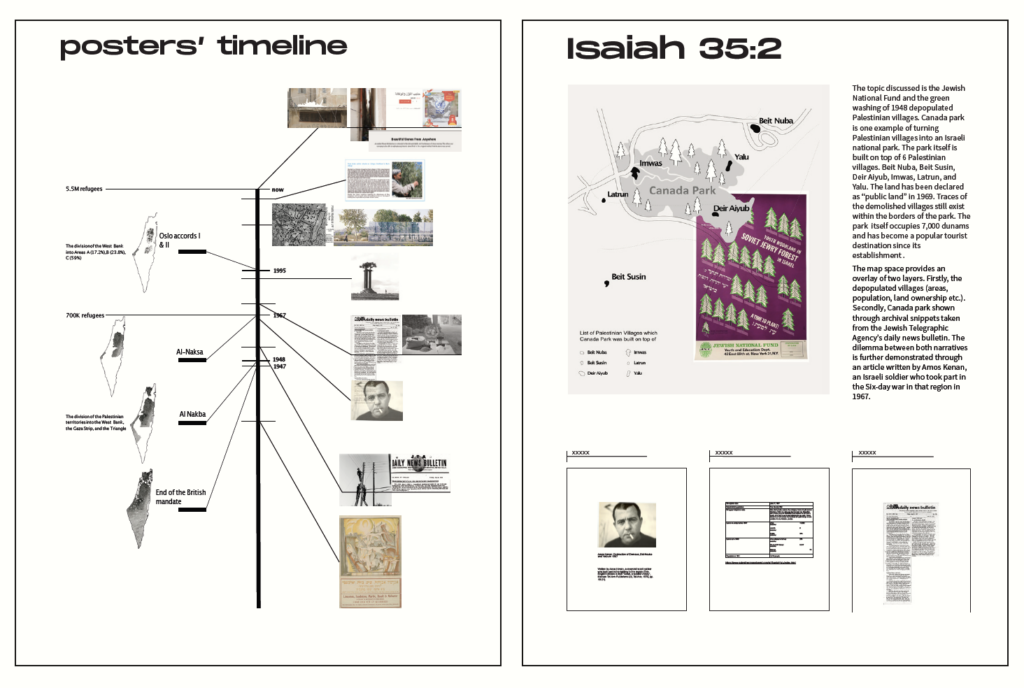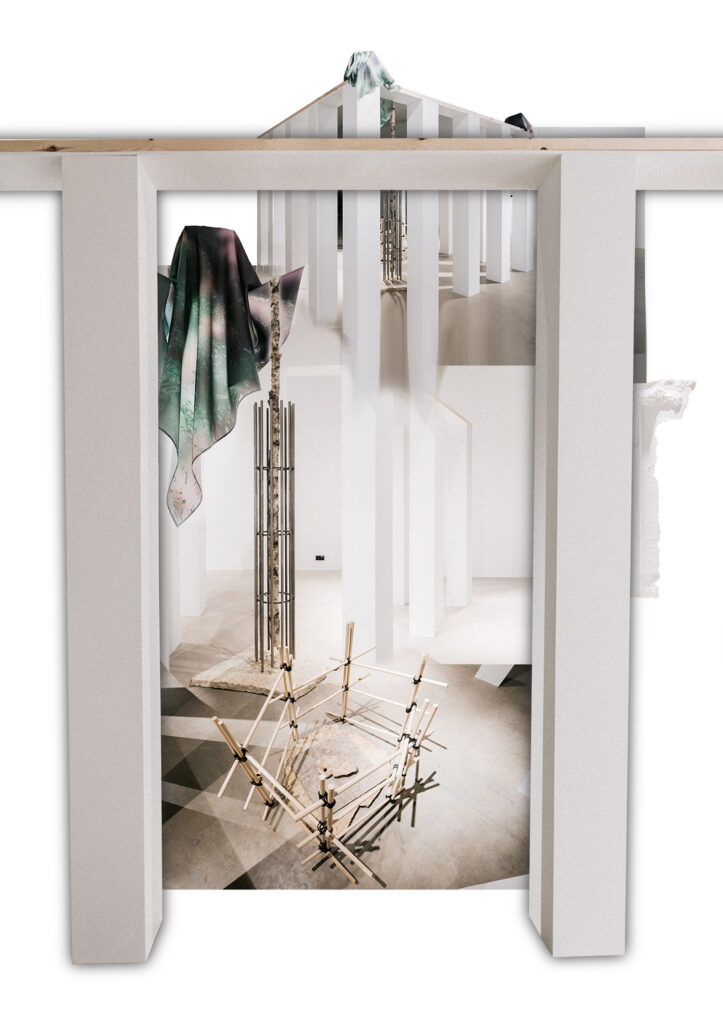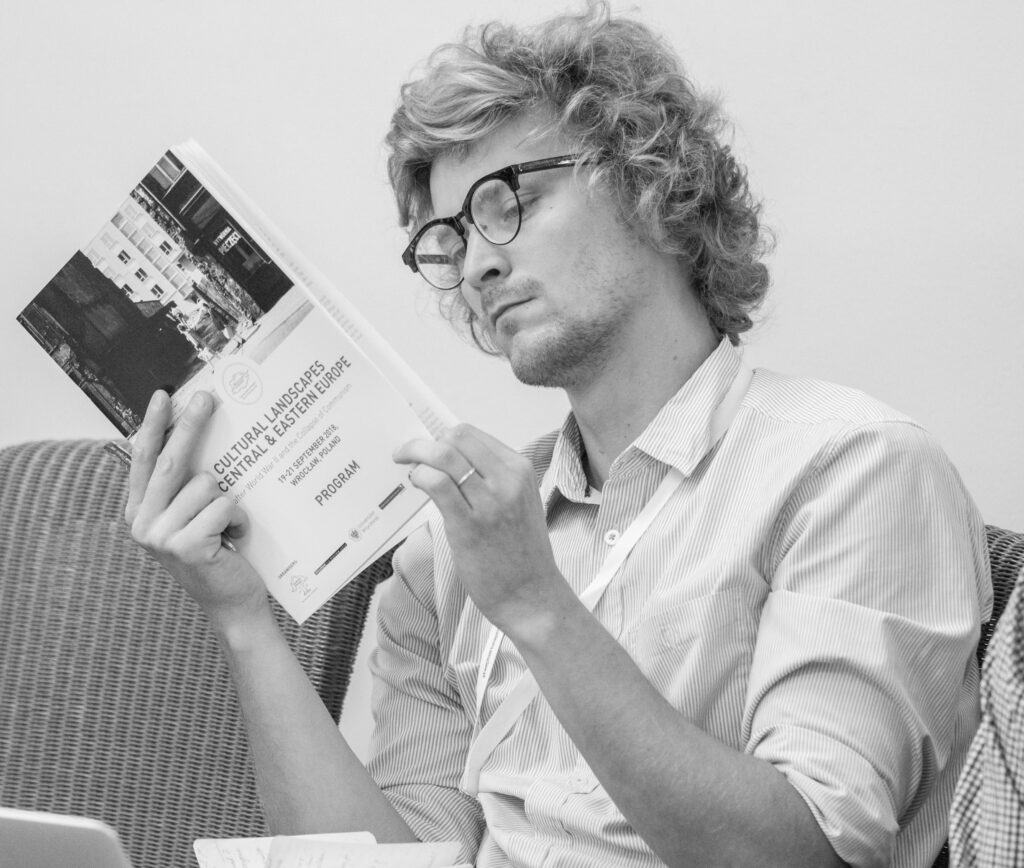Estonian Academy of Arts (EKA) master’s theses in interior architecture demonstrate an ability to raise serious global issues, and a polemical search for what interior architecture could contribute to their resolution.
In his book Mechanization Takes Command: A Contribution to Anonymous History, published in England in 1948, art historian Siegfried Giedion discusses the origin of the terms meuble and mobilier, noting the intersection between mobility and furniture. Namely, in a situation where the entire social order was characterised by insecurity, it was impossible for any mortal being to leave their vital possessions unattended at home for any extended period of time. Thus, for example, when French nobles were not present in their residences, their palaces stood empty. Only the decorations attached to walls and ceilings were left behind, while everything else travelled along with the landlord so that it would not fall prey to looters. Giedion claims that while the building and its inseparable design elements were immeubles, all the other stuff was meubles—mobile, mööbel (the Estonian term for furniture). Given that the French meubles originates in turn from the Latin mobile (movable property), I suspect that the term carried a similar meaning already much earlier. But this is not our main concern here. Here, it is important to note that Giedion wrote in such a praiseful and appreciative manner about mobility and flexibility in furniture design and interior architecture namely in the year 1948—i.e., amid the ruins of the war-ravaged Old World. After all, we know that the totalitarian aspirations of the interbellum period, with various conservative and ‘immobilising’ agendas, had tempted even some otherwise democratically-minded heads. Thus, throughout the 1930s, even some seemingly free societies were dominated by monumental architecture, plastics and art—in the broadest sense of erecting walls that last for a millennium, as a certain fellow put it. In the post-war decades, progressive European intellectuals—many of whom, truth be told, had been in the ‘other boat’ before the war—rushed to demolish, devalue and reinterpret these physical and moral walls. Supple nomadicity, the polar opposite of walls, became the new cultural leitmotif—and this also reflects in Giedion’s call to step on the heels of anonymous mechanisation and appreciate the medieval-style ‘on-the-move’ interior design.
Relatedly, Italian art historian Romy Golan describes in her monograph Muralnomad how the interior architecture of the 1950s became focused on modern tapestry, which fit well with the zeitgeist of the era due to its soft character as well as its ambulant history—Oriental in origin, tapestry first spread to Byzantium and was then imported by the crusaders to Western Europe, where medieval lords carried pieces of tapestry along with them from palace to palace, as if these were tents.


What is the purpose of this long introduction? It seems to me that interior architecture is currently at a substantial crossroads. After all, we do know that the life-span of an interior architecture project is limited to five years, if not even less. Given that we are on the verge of an ecological disaster, this is a sobering fact and does not instil trust in a discipline that requires such a large amount of resources for such a short perspective. Thus, today, every responsible design university starts off by making its students put on green hats and setting them certain moral objectives. So, what does the slogan ‘rather leave it undone’ entail for interior architecture? Several complicated contradictions are afoot that need to be addressed by today’s students in the future. For example, if we as a society were indeed to learn how to skilfully degrow, how to consume and produce less, then this would inevitably undermine nomadicity and intercultural exchange, which to me as a semiotician seem to be the sources of social diversity. I would hope that our green future will not turn out to be short-legged, real-estate oriented and bent on drawing borders.
Having been involved in teaching EKA interior architecture students throughout the last six years, I have witnessed how the world that the students are supposed to enter after graduating is giving rise to anxiety rather than excitement. It is no secret there are rumours going around how even the coolest architectural offices require young interior architects to sit behind the computer from morning to night, toiling away at dull spadework rather than doing something creative. For this reason, students have also started constructing certain ideal worlds for themselves that embody the principles of what doing interior architecture should really consist in. It is noteworthy that one of such is the late Soviet ‘author space’ à la Vello Asi. Appreciation and admiration are now directed at ‘grandfathers’, who had the privileged opportunity to create lasting signature spaces of independent artistic merit that were supported both by astute clients and curious users. Naturally, I am somewhat exaggerating, and students do understand both the upsides and downsides of the socialist period, but still, it is clear that they are dreaming of a conceptually diverse professional life full of exciting challenges rather than simply ‘designing away’.
There are rumours going around how even the coolest architectural offices require young interior architects to sit behind the computer from morning to night, toiling away at dull spadework rather than doing something creative. For this reason, students have constructed certain ideal worlds for themselves that embody the principles of what doing interior architecture should really consist in — one of such is the late Soviet ‘author space’ á la Vello Asi.
Against this backdrop, I would like to briefly introduce two master’s theses from the interior architecture department that gained the highest grade in the current and previous academic year.
Siim Karro’s 2019 thesis ‘Perceptual Despair in the Age of Flatness’ took off precisely from the kind of scenario described above. Karro had completed his bachelor studies a couple of years earlier and subsequently did successful work for the ambitious architectural office KAOS Architects, but nevertheless found the monotony that dominates our spatial culture disconcerting. He then decided to enter the master’s programme, in order to take time to ‘read himself into’ the contemporary critical theories of space that would enable him to make sense of the current insipid situation, as well as to find the means for a deeper practice of his work in the future. While the main instrument in the critical part of the thesis was Fredric Jameson’s analysis of postmodernism as the cultural logic of late capitalism, and the main tool for sharpening creativity was a study of key texts of phenomenology, the most central instrument of the work turned out to be the medium of exhibition. The first exhibition accompanying the thesis was held in the recently opened EKA Gallery and tried to flesh out the ‘perceptual despair in the age of flatness’ of the title in the form of a spatial and sound installation. Given that the exhibition took place six months before the graduation, it was gratifying for me as a supervisor to observe how the work developed synchronously on paper and in practice throughout the year. Many design and art academies have decided that there is no sense in having students in creative fields produce ‘poor research’, for this only serves to inhibit their design ambition and courage after they graduate—yet, studies written with such a burning intensity as Karro’s assure me that we are on the right path. Karro’s thesis concluded with a second exhibition, which was characterised by a huge workload and substantive vigour that rendered it a kind of counterargument to the questions raised in the first exhibition.

In my notes, I have jotted down a comment from Karro’s reviewer Paco Ulman, who said that since both exhibitions consisted in ‘subjective author spaces’, this master’s thesis is almost impossible to grade, and, more generally, it is difficult to see how the author positions himself—is he supposed to be an interior architect, furniture designer, artist or spatial designer? Likewise, the evaluation committee bombarded the student with all sorts of questions, such as—how to apply the author space in planning an urban environment; why do the case studies of the theoretical part of the thesis fail to connect with the installations; why would one use such big words as ‘humane environment’ and ‘realising the full human potential’; and why do the exhibitions neglect stimulating other senses besides sight? Regardless of all the criticisms, the thesis was awarded the sole A of that year. The committee was probably convinced by its clearly stated aims, well-chosen theoretical framework, clever methodology, two capable personal exhibitions and the ambition to engage with the foundations of the discipline as well as the core questions regarding the world the latter is supposed to shape.
Among the graduates of 2020, grade A was awarded to Mariann Drell for her thesis ‘Gender in Space: Normatives and Phenomena through the Gaze of an Interior Architect’. According to the author herself, her study took off when she encountered a restroom with separate sinks designated for men and women. This encounter led to a spatial analysis of gender stereotypes that was enriched by splendidly selected feminist literature, performative spatial games on one’s own body, essayistic writing in a poetic register that positively subverted the usual compressed academic format, stubborn and determined experimental works in a wood workshop and impeccable visual self-expression. Note that having a compelling graphic handwriting does not imply a perfect command of CAD, but rather the skill and passion of creating an independent conceptual and aesthetic world that concentrates the variegation of being under a single roof. Interestingly, just like with Siim Karro in the previous year, reviewer Ingrid Ruudi proposed the grade B for Drell, pointing out that it remains somewhat unclear what the student is seeking to accomplish with her work, what the design ambition consists in and whether the more belletristic parts of the text do not lapse into using too many big words. The chairman of the evaluation committee, Graeme Brooker from the Royal College of Art in Britain criticised the student to some extent for parochial patriotism—the concluding solution in the thesis envisaged building a ‘temple’ at the TASE exhibition in EKA—and encouraged her as well as other students to define themselves as citizens of the world. His comment was stimulating and provocative, even if perhaps a bit unfair with regard to Drell’s work. Looking back at the theses defended in the recent years, it is indeed true that most of the students have tied their projects to working with some particular space. For purely practical reasons, these spaces are usually situated somewhere near—this year, for example, they included Kolga manor, EELC Tallinn Diaconal Hospital and Tallinn Children’s Shelter building on Nõmme street. Personally, I feel that this kind of focus does not indicate a lack of vision, but rather adherence to the slogan ‘think globally, act locally’. Similarly to Siim Karro’s thesis, Drell’s project stimulated many fascinating discussions and stood out for its original contribution to the discipline. Being acquainted with graduate theses written in various faculties of EKA and knowing how perplexed students get when working their way through that process, I am convinced that Drell’s work is going to find many future readers all over the academy and help other young artists, designers or architects to find their own path.

In the last two years, a dozen other young spatial artists besides Karro and Drell have completed the interior architecture master’s programme. Let me say a few words about their works as well. In the spring of 2019, six students defended their master’s theses, all of them in the English-language curriculum: four authors from Estonia, one from Colombia and one from Egypt. We encouraged foreign students to engage with issues of their own countries of origin, but try to find solutions that would be relevant and appreciable in Estonia and other places of the world as well. Colombian student Andrea Liliana Zúñiga Lozano chose to focus on the civil war that has long afflicted her country and tried to find ways of restoring the ‘social fabric’ by the means of interior architecture. Even though the focus of her design project was street furniture that would enhance the economic and social organisation of village life, the work turned out to be a gratifying demonstration of how the torn-apart insides of a country can present an attractive research topic for interior architecture. Egyptian student Amr Gamal’s thesis studied the example of a slum in Alexandria in order to find ways of reducing poverty and social inequality by the means of gradual formalisation of space. As their supervisor, I took great honour and pleasure in the fact that both graduates looked for and found opportunities to continue their careers in Estonia—that is, until the pandemic-related emergency and xenophobic policies of the Estonian government against third-country nationals forced them to leave (temporarily, I would hope).
Other students also tackled bold social topics in their works. For example, Kaia Tungla envisioned how ecologically sustainable composting could become the main method of burial in the future. A grim, yet immensely evocative topic that prompted discussions about the ritualistic nature of our entire culture. Eva-Maria Truusalu’s thesis featured a radical rethinking of kindergarten spaces and was developed into a full paper that earned the Architecture Publication Award from the weekly cultural newspaper Sirp and Maja. Children were also the focus of Helen Teetamm’s thesis, which proposed to replace sandboxes with soilboxes and delved into the mineral and bacterial qualities of soil as well as its unused potential in spatial culture.
This year, there were eight graduates: half of them completed the Estonian-language curriculum, the other half the English-language one. As the chairman of the evaluation committee Graeme Brooker remarked, the subject matter of the graduate theses was surprisingly serious and topical. On the one hand, this demonstrates students’ social sensibility and courage to grapple with big issues; on the other hand, Brooker sees a certain danger here—namely that the design ambition tends to suffer under the weight of such issues. The range of topics was wide: Sandra Goroško looked at the example of Tallinn Children’s Shelter and how to improve the living conditions and self-confidence of underage addicts by the means of co-design; Kristiine Špongolts tried to raise youth awareness about design and the environment by putting together an elective course for the third school stage; and Keiu Albi’s work redesigned the EELC Tallinn Diaconal Hospital into a dignified space for farewells that is comfortable for the dying person, their loved ones as well as employees. Speaking of foreign students, Ahmad Hussein from Jordan focused on the spirituality of architecture by taking cue from the phenomenological literature and experimenting with micro-spaces that offer spiritual repose. Palestinian student Tamara Istanbouli took up the topic of contemporary cartography as she tried to map the political, social and spatial tensions in the refugee camps of the West Bank through the lens of critical theory and an interactive map-space. Both of these high-spirited graduates seem to have tied their near-future with Tallinn.
The word is that EKA Press is preparing to publish an Estonian translation of The Craftsman, a chrestomathic book by Anglo-American sociologist and urbanologist Richard Sennett. In fact, the term ‘craftsman’ does not have a good equivalent in Estonian, as it comprises both the adept and the artisan. The latter has probably acquired a slightly negative connotation in the Soviet period, for the language portal Sõnaveeb of the Institute of the Estonian Language states its meaning as follows: ‘Unthinking labourer with little creative input of their own, especially in the field of art and literature.’ The example sentence that follows is even glummer: ‘He is no brilliant artist, but merely a good artisan’. This kind of attitude is surely not specific to the Estonian language, but the late 20th-century Western world more generally. Sennett’s book, first published in 2008, has helped to bust this myth; indeed, in the course of the last decade, handicraft and applied art have made their way onto the established cultural scene. The journal Craft Research has been published in England since 2010, and research on crafts is also thriving in contexts such as the native crafts programmes of Viljandi Culture Academy. Sennett’s ‘craftsmen manifesto’ does not understand craftsmanship in the narrow sense of manual labour, but looks back in history and analyses these aspects of Western cultural history where it was namely the craftsman mentality that, on the one hand, pushed life forward and, on the other hand, kept time in ‘joint’ due to its steady nature. The craftsman is a nomad who wanders the world and learns a trade, but then, after finding his calling, settles down in his workshop, thus bringing his skills to the community. This is the kind of craftsman’s life that I hope my students will be able to lead in the future.

GREGOR TAUL is a semiotician and art historian by education, freelance cultural critic and doctoral student at the Catholic University of Portugal.
HEADER: Siim Karro’s installation ‘Human. Potential.’ (2019) explored the various uses and stages of wood in creating a sensual and meaningful space. Extract of SIim Karro’s MA thesis ‘Perceptual Despair n the Age of Flatness’. Photo: Johan Huimerind
PUBLISHED: Maja 101-102 (summer-autumn 2020) Interior Design





